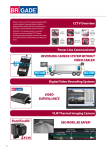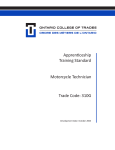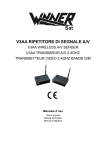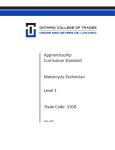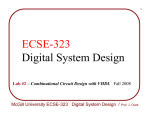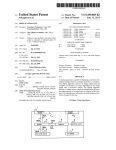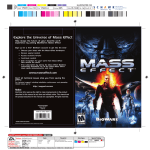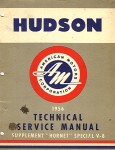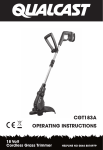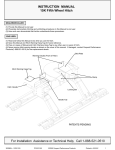Download Tires and Rims - MOL Guideline
Transcript
Health and Safety Resources Caution to Users Many of the resources in this archive were originally prepared by WSN’s predecessor organizations for use by industry clients. While much of the information and many of the forms included with them are still valuable, users should recognize that examples, contact information and data such as legislative references may be out of date. The resources are offered as free tools for companies to use in an effort to continuously improve their health and safety systems. But users of these resources also need to ensure that they are aware of the most recent legislation, equipment and processes, as well as current practices. Health and Safety Guidelines__________________________________________________R.S. 107 1 SUBJECT: WORKING WITH TIRES & WHEEL ASSEMBLIES 107.- (1) Where practical, a motor vehicle in a mine shall carry wheel chocks. (2) Wheel chocks shall be used to block movement when a motor vehicle is left unattended on a slope or is being maintained or repaired. (3) Whenever work is to be performed on a rubber tire with a split rim wheel, a device shall be used to prevent injury to a worker. (4) The device mentioned in subsection (3) is not required when topping off the air pressure in a tire. R.R.O. 1980, Reg. 694, s. 102. DEFINITIONS A rim is the part that supports the tire. There are two types of rims: single piece and multi-piece. The wheel includes parts such as the rim base, flanges, bead seat band, lock rings and O-ring. A wheel assembly includes the wheel with a bolting flange in order to attach the wheel and tire to the vehicle. The tire is the rubber material that runs on the roadway, propelling the vehicle. HISTORY/ORIGINAL INTENT A) Introduction Every year in Ontario several workers handling tires and wheel assemblies are killed or critically injured. A worker was killed in July 2000 while inflating a multi-piece tire on a tractor that had been used in an underground mine. In addition, critical injuries were caused in three accidents during tire inflation in the first half of the year 2000. Tires of various sizes are used on highway trucks, in logging, construction and mining. These tires contain a lot of stored energy in the form of compressed air. This equipment uses multi-piece and single piece wheels, which are subject to fatigue, wear, corrosion and improper assembly. A serious hazard to persons working with any tires and wheel assemblies is the sudden, violent springing of tire lock rings, rims, or flanges from tires with multi-piece wheel _____________________________________________________________________________________ All regulation section numbers refer to the 1990 regulations. Health and Safety Guidelines__________________________________________________R.S. 107 2 assemblies while they are being inflated. A second hazard is the failure of the tire sidewall, either because of weakening during service or from an overpressure. This is called a "zipper rupture" in steel cord radial tires. The steel wires in the sidewall of a radial tire may be weakened by corrosion or due to under inflation or overloading. The blast of air can cause direct injuries or blow pieces of the tire and wheel assembly towards the worker during inflation of the tire. A third hazard is the explosion of tires caused by flammable gases inside the tire. In some cases, the build up of flammable gases inside the tire results from a chemical decomposition, by action of heat called pyrolysis. Pyrolysis can occur if the vehicle's tires/rims/wheels have been heated. This can occur after the vehicle comes near or touches a high voltage power line, after a brake has been heated in a fire, after the wheel has been heated with a torch, after a stud has been cut off a wheel or by welding on the wheel. Parts of the tire and wheel are sent flying with enough energy to cause serious injury. In other cases the flammable gas has been put into the tire either to help bead the tire or from the use of tire inflators used to seal punctures and leaks. B) Typical accident histories The accidents happen while the tires are being inflated, when the wheel assemblies and tires are overheated, when damaged components are improperly repaired and/or used, and when flammable substances are used to seat a stubborn tire. Examples include the following. A worker was critically injured when he was struck by a solid tire ring which blew off a wheel assembly. The workers were increasing the air pressure to a float trailer tire. The float trailer was located near the shop area. The worker sustained a broken left arm, broken right hand and a bruise to the left leg. The tire ring (57 centimeters in diameter) flew approximately 25 metres after hitting the worker. A worker was inflating a transport truck tire when the side wall ruptured throwing him backwards for 4.3 metres (14 feet). He hit the concrete floor and suffered fatal injuries. An 85-ton truck came close to a 138,000 volt line with its elevated box at an open pit mine in Ontario in June 1993. After the truck traveled for about 1000 feet the operator got out to look at the tires, as he heard one blow up. Fortunately, another worker called him away, as all six tires exploded at about 20 second intervals. The truck was seriously damaged from the concussion of the explosions and tire and wheel assembly components were thrown as far away as _____________________________________________________________________________________ All regulation section numbers refer to the 1990 regulations. Health and Safety Guidelines__________________________________________________R.S. 107 3 100 metres. In 2000, a similar accident happened at the same mine, and in this case 3 out of 6 tires exploded. However the precautions from the 1993 accident were in place and injuries were prevented. A mechanic was killed in Saskatchewan in 1998 while removing the left rear wheel from an underground haul truck. The wheel was a detachable rim type, with the tire held in place by a collar and split ring. The collar and split ring were attached to the rim by the outer bolting flange. As the mechanic removed the last nut holding the wheel assembly onto the axle, the rim failed. The failure extended all the way around the rim, and the outer bolting flange was projected away by air pressure. The outer bolting flange flew out from the wheel assembly, striking the mechanic in the chest. The investigation revealed that the rim failed because of extensive fatigue cracks at poorly made welded repairs to the wheel assembly. Three other defective wheels were found at the mine site. The tires were normally changed offsite by another company. The tire had a tube, as otherwise the air would have leaked out through the damaged rim. A worker was killed and another received a broken arm while inflating a tire on an underground tractor at an Ontario mine in July 2000. The multi-piece rim parts were somehow loosened when the tire was flat, the multi-piece rim came apart as it was being inflated. The worker standing in front of the tire was hit and killed by the wheel assembly, while the tire, lock ring and side ring jammed under the fender of the tractor. C) Intent of this Regulation and Guideline The intent of existing 107(3) and (4) is to have a worker protected by a device whenever work is to be performed on a rubber tire with a multi-piece wheel. The intent of the proposed regulations is to alert persons working with tires and wheel assemblies about the various accidents that have happened in the past and to offer safe work procedures. The intent of this guideline is to give advice on the hazards and proper methods to be used while doing any kind of work with tires and wheel assemblies. D) Pertinent regulations from other Programs Construction Section 110 110.- (1) Safety chains, cages or other protection against blown-off side or lock rings shall be used when inflating a tire mounted on a rim. (2) If a cage is used, the tire shall be inflated by remote means. _____________________________________________________________________________________ All regulation section numbers refer to the 1990 regulations. Health and Safety Guidelines__________________________________________________R.S. 107 Industrial Section 77 77. - Safety chains, cages or other protection against blown-off side or lock rings shall be used when inflating a tire mounted on a rim. PERFORMANCE OBJECTIVE The explosive energy inside tires caused by the air pressure or pyrolysis should be relieved before working with damaged wheel assemblies and tires or with overheated tires. When inflating tires, workers should stand in a safe location or should place the tire inside an enclosure that will contain any flying pieces, or secure the pieces with a suitable device such as safety chains made for this specific purpose. Tires and wheel assemblies are subjected to heavy loads and abuse during service, and they must be regularly inspected by a trained person and defective items must be safely removed from service. Explosive gases can be generated inside a tire from a chemical reaction, and persons working with vehicles and tires must be trained to recognize dangerous work practices and to take effective precautions when certain incidents occur. HAZARD An exploding tire can send pieces flying with sufficient energy to cause serious injuries to anyone working on the tire/wheel assembly or to anyone in the trajectory of the pieces of the tire and wheel assembly. GUIDELINES FOR COMPLIANCE A. Training for Persons Working with Tires and Wheel Assemblies _____________________________________________________________________________________ All regulation section numbers refer to the 1990 regulations. 4 Health and Safety Guidelines__________________________________________________R.S. 107 5 Workers must be trained for the tasks that they are expected to fulfill, and to understand the limits of their knowledge of the hazards associated with tires and wheel assemblies. A worker who is required to work with tires and wheel assemblies must be trained to recognize and understand the hazards and to know the correct procedures to use. This work includes: installing/removing tires and wheels, handling wheels, inspecting and repairing tires and wheels, inflating and deflating tires, assembling multi-piece wheels, mounting/demounting tires on wheels and the operator inspecting the tires and wheel assemblies. The training should include being able to use the manufacturer’s information and tire charts so that the correct repair parts can be installed. B. During removal of tires/wheel assemblies from a vehicle Special demounting procedures can be used to safely remove an inflated tire/wheel assembly. These procedures check for unusual movement of the wheel assembly as it is being demounted. These movements are indications of damaged wheels. The air should be completely removed from a tire before the wheel nuts are loosened if there is known or suspected damage to the tire or wheel. Remove the valve core and run a wire through the valve stem to see that it is not blocked. On dual wheels, always inspect the inside tire before removing the cap nuts on the outside wheel. If there is obvious or suspected damage to the inside tire or wheel assembly components, completely deflate both tires. C. Removal of Tires from Wheel Assemblies This work must only be done by a trained tire technician following accepted industry practices. D. Careful Inspection and Replacement of Worn Parts Whenever wheel assemblies are removed from a vehicle, or before they are remounted, the rim base and parts should be cleaned of dirt and rust, disassembled and carefully inspected visually. If there is any evidence of damage or metal fatigue, closer examination using non-destructive methods is required. Parts that are cracked, worn, bent, severely dented, or pitted from corrosion must not be used. They have been weakened and they may not _____________________________________________________________________________________ All regulation section numbers refer to the 1990 regulations. Health and Safety Guidelines__________________________________________________R.S. 107 6 assemble properly. Do not attempt to rework, weld, heat or braze any wheel assembly or component, since heating or reworking may weaken a part to the extent that it will fail during inflation of the tire or while in service. The only exception is if the work is being done by a qualified repair shop. New parts or parts that are undamaged should be used, and these should be of the same size and type as specified by the manufacturer. Current manufacturer's information on the type of wheels being serviced such as tire charts or rim manuals must be available in the service area for the persons doing the work. E. Inflation The tire must always be inflated in a safety cage which will contain flying parts or by using other protection as required for multi-piece wheels such as by using a safety chain specifically made for this purpose. Other protection can include using a remote air valve and gauge and standing in a safe location, away from the trajectory of the wheel components. Refer to Mining Regulation 107(3), Industrial Regulation 77 or Construction Regulation 110 as appropriate. The protection must keep workers out of the line of trajectory of flying lock rings, rims, flanges or parts of the tire. It is recommended that this practice be used for tires on single piece wheels as well. Inflate the tire slowly and carefully while inspecting for proper seating. If adjustments are necessary, deflate the tire by removing the valve core before making changes. A remote air valve and gauge can be used to allow the worker to inflate the tire from a safe location. Never use flammable gases to "explode" a tire onto a rim. Never use a pressure higher than 40 psi to seat the beads or side rings, unless the manufacturer allows higher pressures. Never re-inflate a tire that is flat, has been run flat or run while under-inflated at a pressure that is less than 80% of its recommended pressure. The tire may have become hot enough to weaken the tire or the multi-piece parts may have become separated. Deflate this tire first, inspect it and only then should it be reinflated. F. Overheated Tires Electrical current from a power line contact or near contact, overheated brakes, a vehicle fire heating the brakes, welding on a wheel or even heating wheel nuts can cause a chemical reaction (pyrolysis) inside the tire and the build up of flammable gases. Explosions occur when the gas concentrations exceed a critical level and parts of the tire remain sufficiently hot enough to set off an _____________________________________________________________________________________ All regulation section numbers refer to the 1990 regulations. Health and Safety Guidelines__________________________________________________R.S. 107 7 explosion. If a vehicle has been in contact with overhead high voltage lines, keep all personnel away from the tires until the machine has been moved out of contact with the power lines and the tires have cooled. The operator of the vehicle should exit over the front of the machine or directly into an adjacent machine and should avoid going near the tires. The time required for cooling could be several hours, depending on the size of the tire involved. Fighting a tire fire must be done very cautiously. Do not weld on or near the rim or wheel parts with an inflated tire on it as the tire may explode and, in addition, welding weakens the rim and wheel parts. If a brake has been dragging, or has seized, or is on fire, make sure everyone keeps away from the tire until it has cooled sufficiently. Once an overheated tire has cooled sufficiently, it should be carefully deflated, inspected and re-inflated. There is a possibility that there may be flammable gases inside the tire. G. Use of Aerosol Tire Inflators Many aerosol tire inflators contain flammable propellants. These repair products seal punctures and leaks while inflating the tire. An explosion can occur under certain circumstances. An Information Bulletin from Consumer and Corporate Affairs Canada dated November 18, 1991 contains several good suggestions, including the following. "Consumers and tire repair personnel should: 1. Handle all tires as if a tire inflator/sealer has been used. Customers may neglect to tell tire repair shops or may have even forgotten that an inflator/sealer has been used. 2. NEVER add air to a tire treated with a flammable inflator/sealer without thoroughly removing the flammable gas. If air is added to a tire containing flammable gases, the air/gas mixture in the tire may become more explosive." H. Handling Wheels Assemblies The wheel assemblies on large vehicles can weigh several hundred pounds, and some are over six feet in diameter. Moving such a heavy and awkward object can result in strains and sprains, or broken limbs if one of these wheel assemblies should fall over on the tire handler or others. Care should always be _____________________________________________________________________________________ All regulation section numbers refer to the 1990 regulations. Health and Safety Guidelines__________________________________________________R.S. 107 8 exercised when slinging wheel assemblies overhead (never sling the tire over any person) or when leaving them standing – they should always be secured. I. Handling Tires and Wheel Assemblies on Licensed Vehicles A requirement for Motive Power Equipment under The Trades Qualification and Apprenticeship Act (TQAA) passed into law as O. Reg. 269/96 in September 1996. These requirements came about as a result of the concern for the accidents caused by wheels coming off highway trucks in Ontario. The Motive Power Equipment Regulation (Ontario Regulation 269/96) made under the Trades Qualification and Apprenticeship Act made the removal and replacement of wheels and rims on most coaches, heavy trucks and truck-trailers compulsory to the trades of Truck and Coach Technician and Truck-Trailer Service Technician effective November 1, 1996. Prior to November 1, 1996 wheel and rim removal and replacement on heavy trucks and trailers was an entry level job and there were no requirements to be TQAA qualified. The Apprenticeship and Certification Act, 1998 (ACA) was proclaimed on January 1, 2000 along with a number of related regulations which are now in effect. The motive power trades previously under TQAA are now under ACA. If a worker that is an Apprentice or has a Certificate of Qualification as Truck and Coach Technician or Truck-Trailer Service Technician they are qualified to remove and replace wheels and rims on heavy trucks or trailers. An exemption allows workers who take a course approved by the Director on the removal and replacement of wheels and rims. The Ontario Trucking Association (OTA) offers such a course. Note: "Director means the Director of the Ministry of Training, Colleges and Universities. These requirements only apply to a truck that has been issued a vehicle permit under Ontario legislation. Persons who disassemble, adjust, repair and reassemble wheels and rims for heavy trucks and truck-trailers are designated either as a "truck and coach technician" or a "truck-trailer service technician" and are required to have the training and certification. The regulation includes definitions for "heavy truck" and "truck-trailer". The Ontario Trucking Association's program consists of 8 hours of instruction. Certificates are issued to those who successfully pass a final written examination. The training program covers: inspection of wheel/rim system components, out-of-service criteria, correct preparation for wheel assembly, wheel installation and torquing. Wheel installers work for tire companies and trucking companies and conduct work in shops and at roadsides. Ministry Of Labour inspectors can enforce the provisions of the ACA. If an inspector finds a worker removing or replacing wheels and rims on coaches, _____________________________________________________________________________________ All regulation section numbers refer to the 1990 regulations. Health and Safety Guidelines__________________________________________________R.S. 107 9 heavy trucks, or truck-trailers (licensed for the highway) that does not have the appropriate training, an order should be written. The wording of the orders should be as follows: ORDER TO WORKER (Name of worker) shall provide proof of Apprenticeship or Certification of Qualification as a Truck and Coach Technician or Truck-Trailer Service Technician in accordance with Section 2(1) of O. Reg. 572/99 or proof of successful completion of a course of study approved by the Director on the removal and replacement of wheels and rims or cease removing and replacing wheels and rims on heavy trucks. ORDER TO EMPLOYER The employer shall provide proof of Apprenticeship or Certification of Qualification for (Name of Worker) as a Truck and Coach Technician or TruckTrailer Service Technician in accordance with Section 2(2) of O. Reg. 572/99 or proof that (Name of Worker) has successfully completed a course of study approved by the Director on the removal and replacement of wheels and rims or cease removing and replacing wheels and rims on heavy trucks. REFERENCES a) OSHA - Servicing multi-piece and single piece rim wheels - Regulation 1910.177. b) Mines and Aggregates Safety and Health Association - Technical Report entitled "Tire Explosions Due to Pyrolysis". c) Mines Department of Western Australia - Summary of Proceedings of the Seminar on Tyre Fires and Explosions - Causes and Prevention - Kalgoorlie, Western Australia - May 4-5, 1988. d) Mine Safety and Health Administration - Tire and Rim Safety Awareness Program - dated 1996. e) Ontario Ministry of Skills Development - Apprenticeship Training Standards - Tire, Wheel and Rim Mechanic. f) The ACCURIDE Corporation - Rim/Wheel Safety & Service Manual. g) Hazard Alerts produced by the Ontario Ministry of Labour entitled “Explosion of Tires Ring During Repair” and “Worn or Aging Tire Rims and Components”. _____________________________________________________________________________________ All regulation section numbers refer to the 1990 regulations. Health and Safety Guidelines__________________________________________________R.S. 107 10 h) Hazard Alert by Saskatchewan Labour – “Tire Mount/Demount on Heavy Vehicles” – based on a fatality on February 14, 1998. i) Ontario Regulations under the Apprenticeship and Certification Act and training and certification by the Ontario Trucking Association. j) National Wheel and Rim Association - "Wheel and Rim Safety Manual" REVIEWED BY THE MINING PROGRAM PROVINCIAL ADVISORY COMMITTEE and APPROVED BY PROVINCIAL CO-ORDINATOR - MINING Date: October 23, 2000 Prepared by a sub-committee of the MLRC, whose members are: Randi Condie - United Steel Workers of America Local 6500 Gary Foley - Goodyear Canada Inc. Pat Gibbons - Bridgestone/Firestone Canada Inc. Charlie Kennedy - Ministry of Labour Greg Mascioli - Kidd Creek Mine Don Trottier - North Shore Industrial Wheel Mfg. Charlie Trenka - Ministry of Labour _____________________________________________________________________________________ All regulation section numbers refer to the 1990 regulations.













